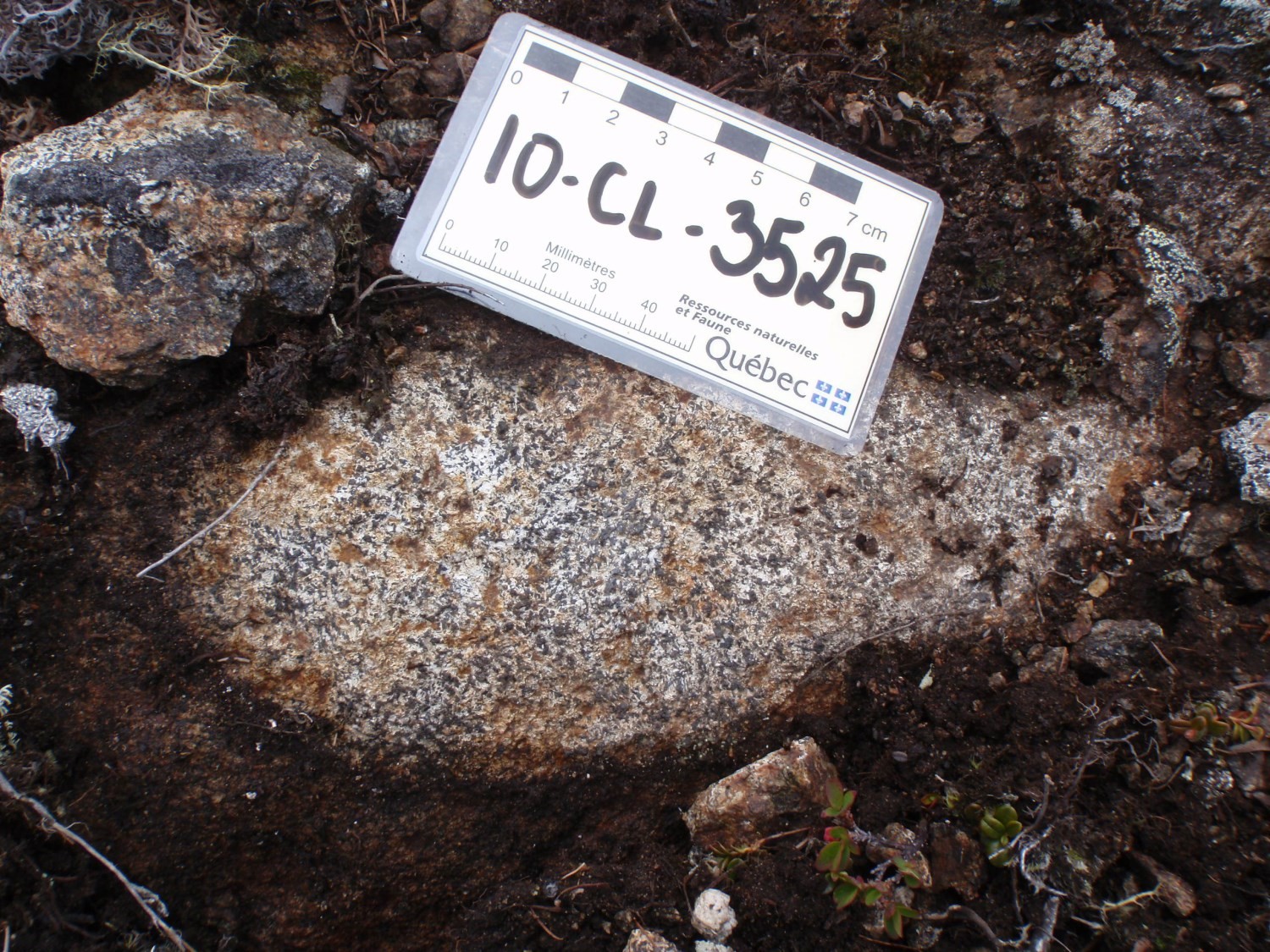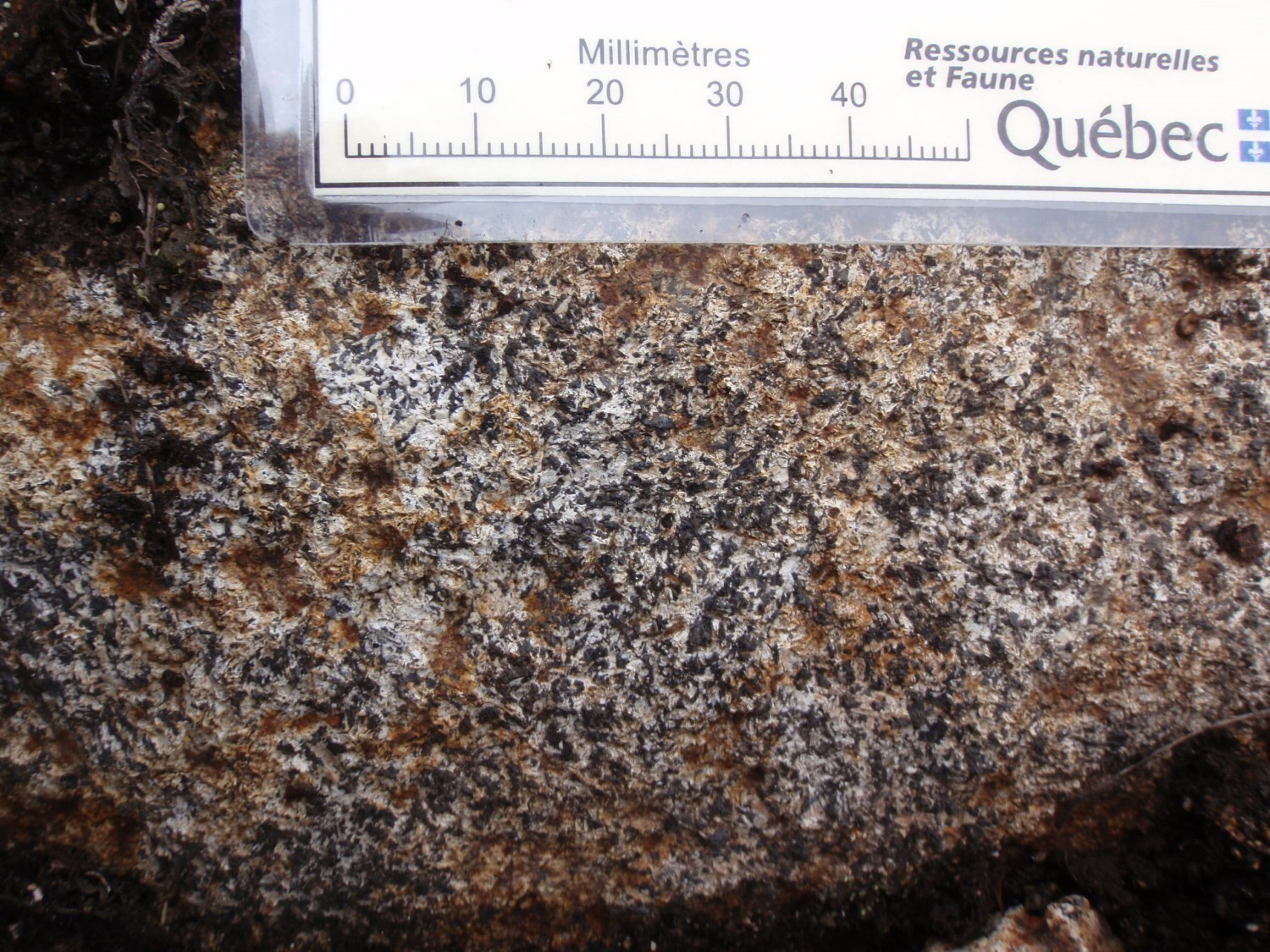
| Author: | Meyers and Emslie, 1977 |
| Age: | Mesoproterozoic |
| Stratotype: | None |
| Type area: | Nutak region of Labrador (NTS sheets 14F03,14F04 and 14C13) |
| Geological province: | Churchill Province and Nain Province |
| Geological subdivision: | Mistinibi-Raude, George and Baleine lithotectonic domains |
| Lithology: | Ophitic olivine gabbro |
| Category: | Lithodemic |
| Rank: | Suite |
| Status: | Formal |
| Use: | Active |
None
Background
The Harp Dykes were introduced by Meyers and Emslie (1977) in Labrador to group a swarm of ophitic gabbro dykes oriented NE-SW to ENE-WSW. They were further subdivided by Cadman et al. (1993) from geochemistry. These dykes transcend the boundary between Quebec and Labrador and have been described by Hammouche et al. (2011, 2012) in the Bonaventure Lake and Zeni Lake areas. They were also observed in the northern part of the Résolution Lake area in checks conducted as part of the synthesis of the Southeastern Churchill Province (SECP; Lafrance et al., 2018).
Description
The Harp Dykes were subdivided into three groups by Cadman et al. (1993) using spider diagrams. These subdivisions have been named according to three type localities: Harp UT (Umiatoriak Island), Harp PT (Pitsiutatsitikulluk Island) and Harp CO (Comma Island). Both Harp UT and PT dykes have a positive barium anomaly, but Harp PT dykes also have a negative phosphorus anomaly. Harp CO dykes are also characterized by a negative phosphorus anomaly and have a slightly different orientation from other dykes, ranging from NE-SW to N-S. A priori, dykes sampled in Quebec appear to be Harp UT dykes.
Dykes are not very exposed and have only been observed on a few isolated outcrops in Quebec. However, they are readily identifiable on aeromagnetic maps where they form positive linear anomalies. Dykes consist of massive olivine gabbro, blackish grey in fresh exposure and brownish yellow in alteration patina. Gabbro is either medium grained in the centre of dykes, or very fine grained to aphanitic at the edge and in smaller dykes. Devitrified glass was observed in a small dyke in Labrador (Meyers and Emslie, 1977). Rocks of both facies have a subhedral ophitic texture and are mostly composed of plagioclase, clinopyroxene and olivine. In addition to these minerals, the matrix contains small amounts of K-feldspar, quartz, biotite and apatite. Plagioclase forms euhedral to subhedral laths and interstitial grains in the matrix. Laths are zoned and contain serpentinized olivine and fine crystals of clinopyroxene and opaque minerals. Plagioclase is variably saussuritized. Accessory minerals are chlorite, epidote and zoisite, as well as serpentine and iddingsite, in fractures of olivine grains or as a complete replacement locally. Serpentinization is accompanied by many very fine opaque minerals, possibly magnetite, located inside and around olivine.
The fine-grained facies contains disseminated plagioclase and olivine phenocrystals. Several samples contain submillimetric amygdules filled with quartz, calcite and epidote, or chlorite and zeolite (Meyers and Emslie, 1977). In the medium-grained facies, clinopyroxene forms interstitial poikilitic masses containing olivine inclusions and displaying polygonal extinction.
Thickness and Distribution
Meyers and Emslie (1977) report that the majority of dykes are 50 m wide or more. In Quebec, magnetic lineaments suggest an average width of 100 m and can reach more than 65 km in length. These dykes are located in the SE part of the SECP and in the Nain Province, in Labrador. More specifically, in Quebec, they are concentrated in the SE portion of sheet 23P, as well as in sheets 13M04, 13M05 and 13M12. The Harp Dykes are mostly concentrated in the Mistinibi-Raude Lithotectonic Domain (14 dykes; Lafrance et al., 2019), but have also been observed in the George (6 dykes; Charette et al., 2018) and Rachel-Laporte (2 dykes) domains.
Dating
A crystallization age of 1273 ±1 Ma on baddeleyite and zircon (Cadman et al., 1993) was obtained on a Harp UT mafic dyke cutting the Archean Hopedale block in Labrador. Three other geochronological studies of dykes identified as part of the Harp swarm (Cadman et al., 1993) yielded ages of 1316 ±94 Ma (K-Ar; Wanless et al., 1978), 1350 ±280 Ma (R-Sr; Ashwal et al., 1986) and 1206 ±122 Ma (Voner, 1985).
Stratigraphic Relationship(s)
The Harp Dykes are one of the youngest units in the SECP. Among others, they cut the Mistastin Batholith, De Pas Supersuite, Dumans Suite, and the Advance, Zeni, Saint-Sauveur, Bourdon and Mistinibi complexes. In Labrador, the Harp Dykes cut the Harp Lake Intrusive Suite (Meyers and Emslie, 1977; Kerr and Hamilton, 2014).
Paleontology
Does not apply.
References
| Author(s) | Title | Year of Publication | Hyperlink (EXAMINE or Other) |
|---|---|---|---|
| ASHWAL, J.H. – WOODEN, J.L. – EMSLIE, R.F. | Sr, Nd and Pb isotopes in Proterozoic intrusives astride the Grenville front in Labrador: implications for crustal contamination and basement mapping. Geochimica et Cosmochimica Acta; volume 50, pages 2571-2585. | 1986 | Source |
| LAFRANCE, I. – CHARETTE, B. – VANIER, M.-A. | Sud-est de la Province de Churchill, Nunavik, Québec, Canada : synthèse de la géologie. Ministère de l’Énergie et des Ressources naturelles, Québec. | 2018 | Bulletin géologiQUE |
| CHARETTE, B. – LAFRANCE, I. – VANIER, M.A. | Domaine de George, sud-est de la Province de Churchill, Nunavik, Québec, Canada : synthèse de la géologie. Ministère de l’Énergie et des Ressources naturelles, Québec. BG 2018-11. | 2018 | BG 2018-11 |
| MEYERS, R.E. – EMSLIE, R.F.E. | The Harp dikes and their relationship to the Helikian geological record in central Labrador. Canadian Journal of Earth Sciences; volume 14, pages 2683-2696. | 1977 | Source |
| CADMAN, A.C. – HEAMAN, L. – TARNEY, J. – WARDLE, R. – KROGH, T.E. | U–Pb geochronology and geochemical variation within two Proterozoic mafic dyke swarms, Labrador. Canadian Journal of Earth Sciences; volume 30, pages 1490–1504. | 1993 | Source |
| HAMMOUCHE, H. – LEGOUIX, C. – GOUTIER, J. – DION, C. | Géologie de la région du lac Zeni. Ministère des Ressources naturelles, Québec; RG 2012-02, 35 pages, 1 plan. | 2012 | RG 2012-02 |
| KERR, A. – HAMILTON, M.A. | Rare-Earth Element (REE) mineralization in the Mistastin lake and Smallwood reservoir areas, Labrador: field relationships in: preliminary U-Pb zircon ages from host granitoid rocks. Newfoundland and Labrador Department of Natural Resources, Geological Survey, Current Research, Report 14-1, pages 45-62. | 2014 | Source |
| LAFRANCE, I. – CHARETTE, B. – VANIER, M.-A. – GODET, A. | Domaine de Mistinibi-Raude, sud-est de la Province de Churchill, Nunavik, Québec, Canada : synthèse de la géologie. Ministère de l’Énergie et des Ressources naturelles, Québec. BG 2019-07. | 2019 | BG 2019-07 |
| VONER, F.R. | Crustal evolution of the Hopedale block, Labrador, Canada (geochronology). Ph.D. thesis, Miami University, Miami, 136 pages. | 1985 | – |
| WANLESS, R.K. – STEVENS, R.D. – LACHANCE, G.R. – DELABIO, R.N. | Age determinations and geological studies, K-Ar isotopic ages. Geological Survey of Canada; Report 11, pages 52-54. | 1978 | Source |


